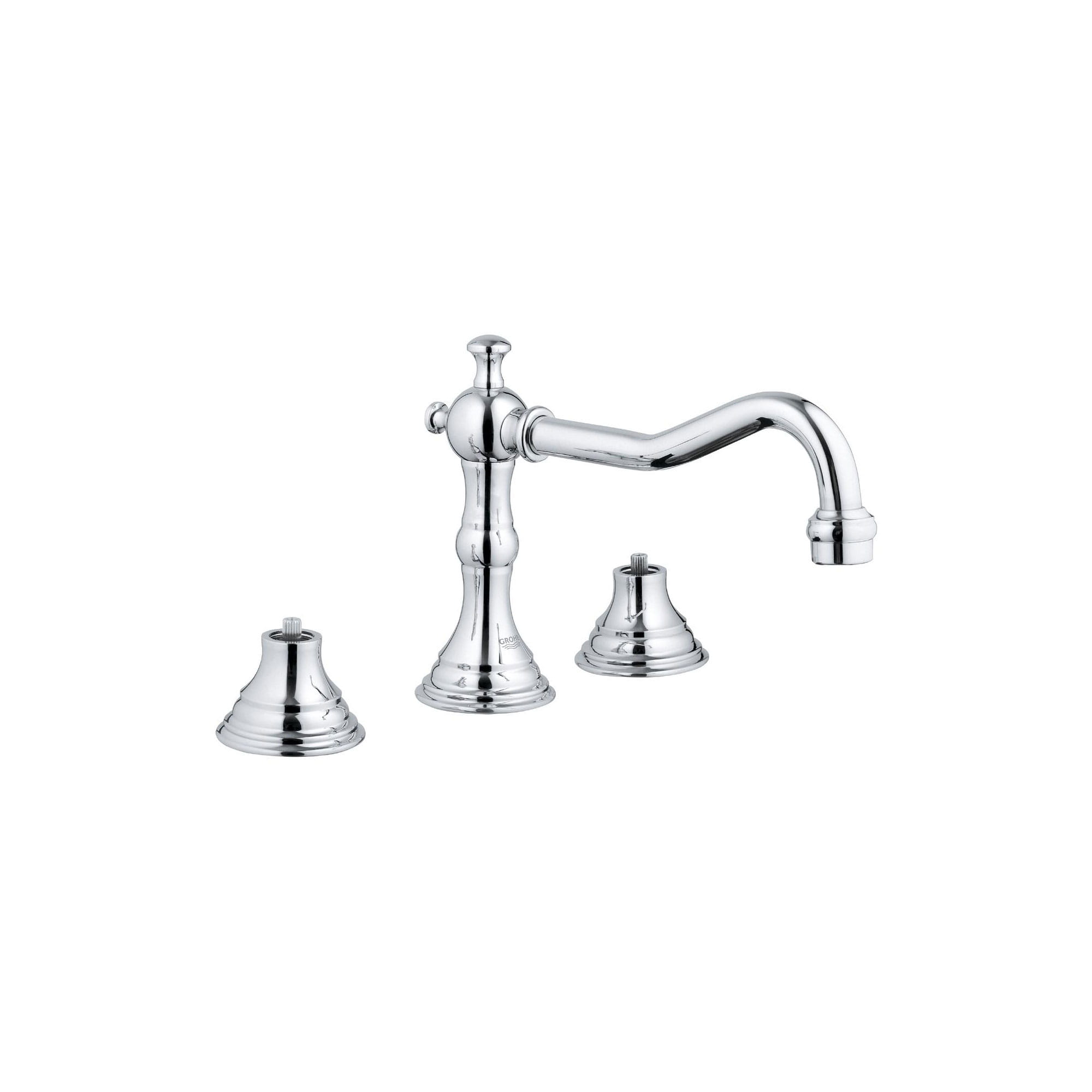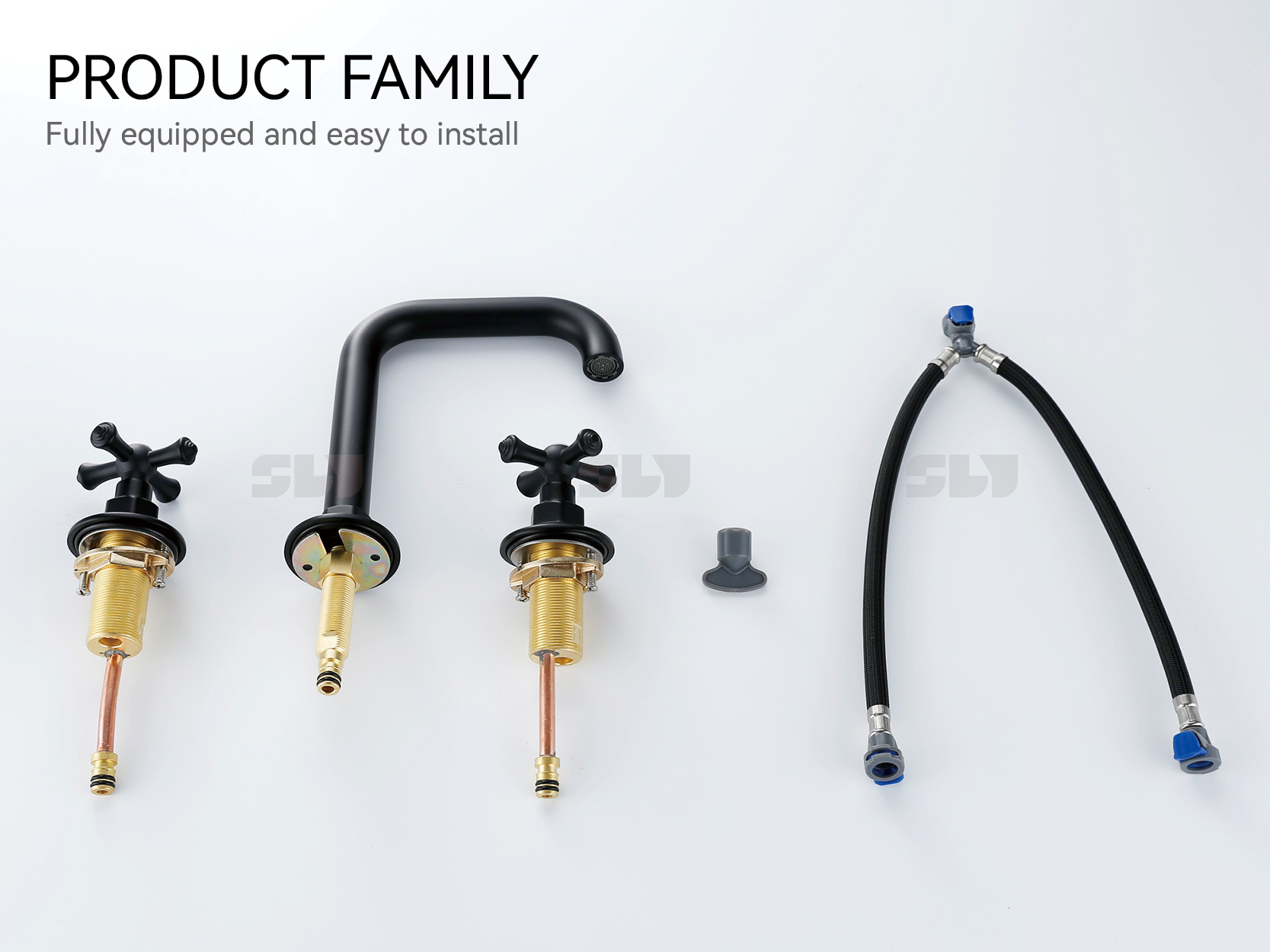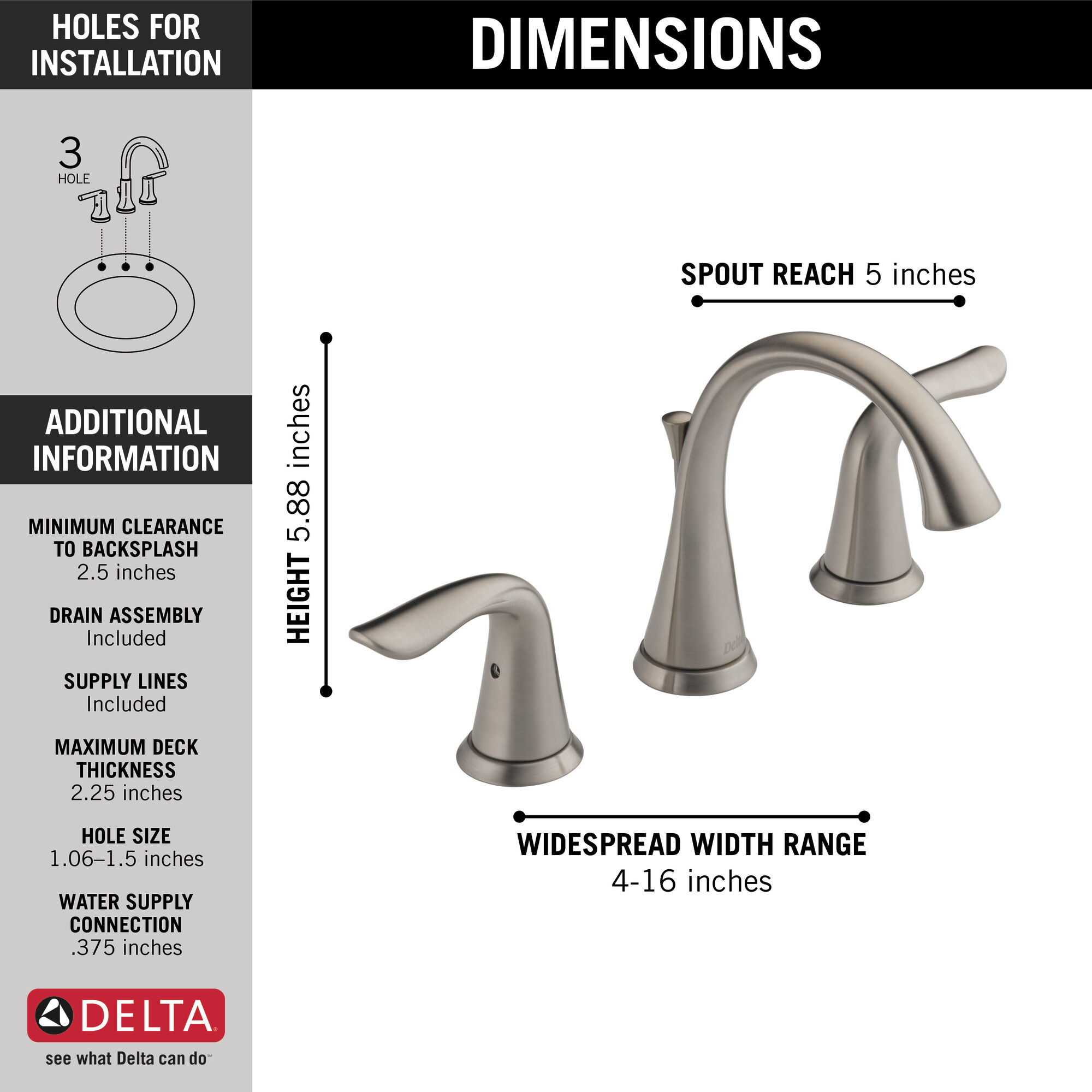Introduction to 3-Hole Widespread Bathroom Faucets

The 3-hole widespread bathroom faucet, a staple in traditional and contemporary bathroom designs, offers a unique blend of functionality and aesthetics. This faucet style, characterized by its three distinct holes for mounting, has a rich history, evolving alongside bathroom design trends. Let’s delve into the defining features, historical context, and the advantages and disadvantages of this enduring faucet style.
Defining Features of 3-Hole Widespread Bathroom Faucets
The defining feature of a 3-hole widespread bathroom faucet is its three distinct holes, typically spaced 8 inches apart. These holes accommodate the faucet’s spout, hot and cold handles, and often a separate escutcheon plate for a polished look. The handles can be lever-style, cross-style, or knob-style, offering diverse aesthetic options. The widespread design provides ample space for the handles, allowing for easy manipulation and control of water flow and temperature.
History of 3-Hole Widespread Bathroom Faucets
The widespread bathroom faucet’s history traces back to the early 20th century, when bathrooms began to transition from utilitarian spaces to more luxurious and decorative environments. The widespread design, with its distinct handles and spacious layout, offered a more refined and elegant aesthetic compared to the single-hole and centerset faucets prevalent at the time. As bathroom design evolved, the 3-hole widespread faucet became a symbol of sophistication and style, gaining popularity in both traditional and modern homes.
Advantages of 3-Hole Widespread Bathroom Faucets
- Enhanced Control: The spacious design of 3-hole widespread faucets provides ample room for the handles, allowing for precise control of water flow and temperature. This is particularly beneficial for users with dexterity limitations or those who prefer a more tactile experience.
- Aesthetic Versatility: The 3-hole widespread design offers a wide range of handle styles, finishes, and materials, allowing for seamless integration into diverse bathroom aesthetics. From classic cross-style handles to sleek lever designs, the possibilities are endless.
- Enhanced Durability: The robust construction of 3-hole widespread faucets, with their sturdy mounting plates and separate handles, contributes to their long-term durability. These faucets are built to withstand the rigors of daily use, ensuring a long lifespan.
Disadvantages of 3-Hole Widespread Bathroom Faucets
- Installation Complexity: Installing a 3-hole widespread faucet requires precise measurements and drilling to ensure proper alignment of the three holes. This can be challenging for DIY enthusiasts, often requiring professional assistance.
- Space Constraints: The widespread design necessitates sufficient space on the sink or countertop for the three holes. This can be a limitation in smaller bathrooms or where counter space is at a premium.
- Higher Cost: 3-hole widespread faucets often have a higher price point compared to single-hole or centerset options. The complex construction and design elements contribute to their increased cost.
Types of 3-Hole Widespread Bathroom Faucets

Choosing the right 3-hole widespread bathroom faucet involves considering several factors, including style, finish, and material. These factors will help you create the perfect look and feel for your bathroom.
Spout Styles
The spout style of a 3-hole widespread bathroom faucet is a key factor in determining its overall aesthetic.
- Single-Lever: These faucets feature a single lever that controls both hot and cold water flow. They are easy to use and offer precise temperature control.
- Double-Lever: These faucets have separate levers for hot and cold water. They offer a more traditional look and feel.
- Widespread: This type of faucet has the hot and cold water controls positioned separately on the countertop, typically with a center-set spout. This provides a more spacious and functional layout.
- Centerset: Centerset faucets have the hot and cold water controls positioned closer together, with a center-set spout. They are ideal for smaller bathroom spaces.
Finishes
The finish of your 3-hole widespread bathroom faucet is a significant factor in its appearance and how it complements your bathroom decor.
- Chrome: A classic and popular choice, chrome offers a sleek, modern look and is easy to clean.
- Nickel: Nickel provides a slightly warmer and more sophisticated look than chrome. It is also resistant to corrosion and tarnish.
- Bronze: Bronze finishes create a warm, rustic, and elegant look. They are often used in traditional and farmhouse-style bathrooms.
- Brushed Nickel: This finish has a slightly textured appearance, giving it a more contemporary and industrial feel.
- Oil-Rubbed Bronze: This finish has a dark, rich brown color with a subtle sheen. It provides a vintage and sophisticated look.
Materials
The materials used in the construction of a 3-hole widespread bathroom faucet can significantly impact its durability, longevity, and price.
- Brass: Brass is a durable and corrosion-resistant material commonly used in high-quality faucets. It is also easy to clean and maintain.
- Ceramic: Ceramic is often used for the faucet’s cartridges and valves. It is known for its durability and ability to withstand high water pressure.
- Stainless Steel: Stainless steel is a highly durable and corrosion-resistant material that is also easy to clean. It is often used for the faucet’s body and spout.
Design Considerations: 3 Hole Widespread Bathroom Faucet
The design of your bathroom faucet is more than just a functional choice; it significantly impacts the overall aesthetic of your bathroom. A well-chosen faucet can elevate the look and feel of your space, while a poorly chosen one can detract from it. The key is to select a faucet that complements your bathroom’s style and complements the other fixtures and finishes.
Faucet Style and Bathroom Design
The style of your faucet should align with the overall design theme of your bathroom. Consider the following:
- Traditional Bathrooms: Traditional bathrooms often feature ornate details, rich colors, and classic designs. To complement this style, choose a faucet with a vintage or antique aesthetic. Look for faucets with intricate details, such as cross handles, curved spouts, and polished finishes like nickel or brass.
- Modern Bathrooms: Modern bathrooms are characterized by clean lines, minimalist details, and sleek fixtures. For this style, opt for a faucet with a contemporary design. Look for faucets with geometric shapes, square or rectangular handles, and brushed finishes like chrome or stainless steel.
- Transitional Bathrooms: Transitional bathrooms bridge the gap between traditional and modern styles. They feature a blend of classic and contemporary elements. For this style, choose a faucet with a transitional design. Look for faucets with a slightly more ornate look than a modern faucet, but with cleaner lines than a traditional faucet.
Comparison with Other Faucet Styles
Choosing the right bathroom faucet style can significantly impact your bathroom’s overall look and functionality. While 3-hole widespread faucets offer a classic and elegant design, they are not the only option available. Let’s explore how they stack up against other popular faucet styles, such as centerset and single-hole faucets, to help you make an informed decision.
Comparison of 3-Hole Widespread, Centerset, and Single-Hole Faucets
The choice between 3-hole widespread, centerset, and single-hole faucets depends on your specific needs and preferences. Each style presents distinct advantages and disadvantages in terms of functionality, aesthetics, and installation complexity.
- 3-Hole Widespread Faucets: These faucets feature a widespread design, with the hot and cold water handles spaced apart, typically 8-16 inches, and requiring three holes in the sink or countertop for installation. They are known for their classic and elegant appearance, providing ample space for comfortable operation. However, they require a larger sink or countertop to accommodate the three holes.
- Centerset Faucets: Centerset faucets are characterized by a compact design, with the hot and cold water handles positioned close together, usually within 4 inches, and requiring only two holes for installation. This design is ideal for smaller sinks or countertops and offers a more traditional aesthetic. However, centerset faucets may lack the spaciousness of widespread options, leading to potential discomfort for users with larger hands.
- Single-Hole Faucets: Single-hole faucets, as the name suggests, require only one hole for installation. They are typically equipped with a single lever for controlling both hot and cold water flow. This design is highly space-efficient and offers a modern and sleek aesthetic. However, single-hole faucets may be less adaptable to existing sink configurations and can be more expensive than other options.
Advantages and Disadvantages of Each Style
Each faucet style presents unique advantages and disadvantages that should be considered when making a decision.
- 3-Hole Widespread Faucets:
- Advantages: Classic and elegant design, spacious and comfortable operation, adaptable to various sink styles.
- Disadvantages: Requires a larger sink or countertop, more complex installation, potentially higher cost.
- Centerset Faucets:
- Advantages: Compact design, suitable for smaller sinks, traditional aesthetic, typically less expensive.
- Disadvantages: Less spacious operation, may be less comfortable for users with larger hands, limited design options.
- Single-Hole Faucets:
- Advantages: Space-efficient, modern and sleek design, easy installation, wide range of styles and finishes.
- Disadvantages: Less adaptable to existing sink configurations, may be more expensive, limited handle options.
Scenarios for Suitable Faucet Styles, 3 hole widespread bathroom faucet
The choice of faucet style should align with the specific requirements of your bathroom and your personal preferences.
- 3-Hole Widespread Faucets: Ideal for bathrooms with larger sinks and countertops, where a classic and elegant design is desired.
- Centerset Faucets: Suitable for bathrooms with smaller sinks and countertops, where a traditional aesthetic is preferred.
- Single-Hole Faucets: Perfect for modern bathrooms with space constraints, offering a sleek and contemporary look.
Emerging Trends in Bathroom Faucet Design

The world of bathroom faucets is constantly evolving, driven by a desire for both functionality and style. As technology advances and sustainability becomes increasingly important, we see innovative features being incorporated into bathroom faucet design, particularly in the 3-hole widespread category.
Smart Technology
Smart technology is transforming the way we interact with our homes, and bathroom faucets are no exception. Smart faucets offer a range of features that enhance convenience, efficiency, and safety.
- Touchless Operation: Smart faucets utilize sensors to activate water flow, eliminating the need for manual contact. This is particularly beneficial for maintaining hygiene and reducing the spread of germs. The Kohler Artifacts Touchless Bathroom Faucet is a prime example, offering a hands-free experience with its sensor-activated technology.
- Temperature Control: Some smart faucets allow users to pre-set water temperature, ensuring a comfortable and consistent experience. The Delta Trinsic Touch2O.XT Smart Faucet features a digital display that allows users to program their preferred water temperature.
- Water Conservation: Smart faucets can incorporate flow control mechanisms that reduce water consumption without compromising performance. The Moen Align Smart Faucet boasts a built-in flow restrictor that limits water usage while still delivering a satisfying water flow.
